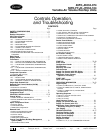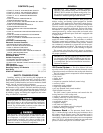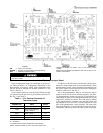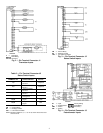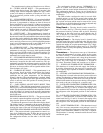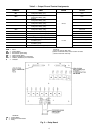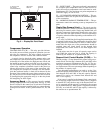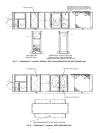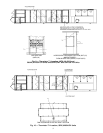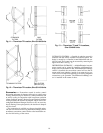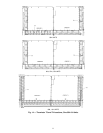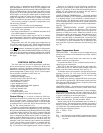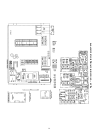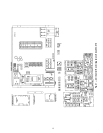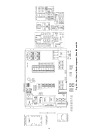The potentiometer locations and functions are as follows:
P1 — SUPPLY-AIR SET POINT — This potentiometer is
located on the display board. The supply-air set point is the
cooling mode control temperature which the VAV control
system will attempt to maintain at Thermistor T1 by con-
trol of economizer position and/or cycling unloaders and
compressors.
P2 — ECONOMIZER POSITION — Economizer feedback
potentiometer is located on the economizer motor. The micro-
processor is programmed to indicate an alarm if the travel
during initialization is less than 10% of the total potentiom-
eter’s resistance.An alarm condition will also be signaled if
the potentiometer fails during operation, indicating that the
damper blades are stuck. If either situation occurs, the pro-
cessor will try to drive the economizer dampers closed.
P3 — RESET LIMIT — This potentiometer is located on
the accessory board (provided standard from the factory) in
the unit main control box and establishes the maximum amount
of reset that can be applied to the supply-air set point (P1).
Reset is limited by the P1 default of 70 F. This potentiom-
eter is used only when accessory, field-installed temperature
reset is used. If temperature reset is used, DIP (dual, in-line
package) switch 2 must be in the ON position.
P4 — DEMAND LIMIT — This potentiometer is located
near TRAN4 in the unit control box. The demand limit po-
tentiometer is used only if accessory, field-installed demand
limit is used, and if DIP switch 5 is in the ON position. For
single-step demand limit, a field-installed 5 to 20 Kohm po-
tentiometer and switch must be used.
P5 — ECONOMIZER MINIMUM POSITION — This po-
tentiometer is on the accessory board (provided standard from
the factory) located in the unit main control box. This po-
tentiometer specifies the minimum opening position for the
optional economizer. If a fault condition is detected by the
processor, an alarm condition will be signaled and the econo-
mizer dampers will close.
P6 — WARM-UP SET POINT — This potentiometer is on
the accessory board (provided standard from the factory)
located in the unit main control box. This potentiometer
establishes the set point temperature for the Morning
Warm-Up function. When the temperature is reached, Morn-
ing Warm-Up is terminated and VAV operation begins. DIP
switch 4 must be in the ON position if morning warm-up
heat is to be used.
P7 — SASP (SUPPLY AIR SET POINT) RESET TEM-
PERATURE — This 10 Kohm potentiometer is used only if
the accessory, field-installed temperature reset package is in-
stalled. This potentiometerdetermines the temperature at which
reset will begin. It is located on the accessory temperature
reset board. DIP switch 2 must be in the ON position to en-
able SASP reset.
PROCESSOR BOARD OUTPUTS — The processor board
also controls outputs through the relay board. The relay board
plugs into the processor board using a ribbon cable.
In addition, the processor board controls the display board.
The display board is connected to the processor board by a
ribbon cable, and has an LED (light-emitting diode) display
showing the status of the unit and diagnostic information.
CONFIGURATION HEADERAND DIPSWITCHASSEM-
BLY — The processor board is programmed to control a va-
riety of air conditioning units. To tailor the processor to the
particular unit being controlled, 2 devices are used. One is
the configuration header, and the other is the DIP switch
assembly.
The configuration header (part no. 30GB660001) is a
series of 8 small wires that are broken or unbroken in a
pattern to indicate several unique characteristics of the unit.
The configuration header is factory set and should not be
changed. Changing the factory setting may cause the unit to
malfunction.
The DIP switches configure the unit for several field-
installed options, as well as for several other options that
may be unique to the unit. The DIP switches are located un-
der a plastic enclosure which must be removed for access.
The switches can be field adjusted, but must be adjusted only
when the unit control circuit breaker is off.
Relay Board — The relay board is used to control 24-v
and 115-v loads. See Fig. 5. The relay board is connected to
the processor board by a ribbon cable at pin J9. Electrical
connections to the relay board are made through pins J5
(115 v) and J6 (24 v). The relay board has eight 24-v relays
and five 115-v relays. See Table 3.
Display Board — The display board is located in the
main unit control box and is connected to the J10 port of the
processor board through a ribbon cable. The display board
contains the supply-air set point potentiometer P1; a 2-digit,
LED display; and the display button (see Fig. 6). The LED
display is used to convey the operating information and op-
erational error codes.
Thermistors — The processor uses up to 5 thermistors
to sense the temperatures at various points in the system.
See Table 1 and Fig. 7-14. All the thermistors have identical
temperature versus resistance and voltage drop characteris-
tics, and are monitored by the processor for a short or open
circuit. The valid range for a thermistor is 362,640 to
219 ohms. Thermistor details and locations are as follows:
T1 — SUPPLY-AIR TEMPERATURE THERMISTOR —
This thermistor is located in the unit supply fan discharge.
It provides information for the processor to stage the num-
ber of capacity steps required to maintain a desired supply-
air temperature.
T2 — RETURN-AIR TEMPERATURE THERMISTOR —
This thermistor is located in the mixed-air portion of the unit
cabinet. The thermistor’s primary function is to provide morn-
ing warm-up information. This sensor will also provide dif-
ferential information for the processor during cooling opera-
tion (such as the rate of change for a capacity step).
T3 — SATURATED CONDENSING TEMPERATURE, CIR-
CUIT 1 — This thermistor is located on the condenser coil
return bend. See Fig. 13 and 14. It controls the staging of the
unit condenser fans based on the condensing temperature of
the refrigerant at the designated position on the condenser
coil.
T4 — SATURATED CONDENSING TEMPERATURE, CIR-
CUIT 2 — This thermistor is located on the condenser coil
return bend. See Fig. 13 and 14. It controls the staging of the
unit condenser fans based on the condensing temperature of
the refrigerant at the designated position on the condenser
coil.
T10 — RESET TEMPERATURE — This thermistor is used
only if the accessory temperature reset package is used. It
provides occupied space temperature information to the pro-
cessor, which determines whether or not reset is required.
The thermistor is remotely mounted outside the unit in the
conditioned space.
5



